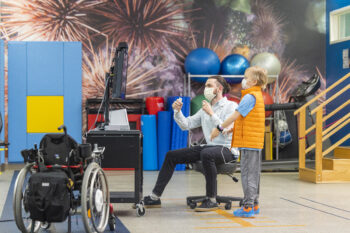
Seattle Children’s Therapeutic Gaming Program brings the power of video games, virtual reality and other therapeutic technology to enhance patient experiences and improve outcomes.
The program uses a variety of video games, consoles and technologies to help patients cope with the stress and boredom of hospitalization, as well as to provide opportunities for socialization, education and rehabilitation.
Since its inception in 2018, thanks to grant funding from Child’s Play Charity, the program has become a leader in the field of therapeutic gaming.
Staffed by a team of trained Therapeutic Gaming Specialists and volunteers, the group works closely with Certified Child Life Specialists, patients and families to provide gaming experiences that are tailored to the individual needs and interests of each patient.
Garrett Goody, one of the founders of the program, has overseen the evolution over the past five years. He said, “When we started, there were three other hospitals doing this work. I started off as one of four gaming specialists in the country, now there’s about fifty of us. My position also evolved from being not just someone to manage the technology, but someone to be a bridge between Certified Child Life Specialists, volunteers, providers and the patients.”
Today, in addition to managing the distribution and maintenance of more than 100 devices on any given day and conducting an average of 200 patient visits per month, therapeutic gaming specialists are a knowledgeable source for technology needs and assessments across the hospital.
Gaming tools are often used to supplement medical progress with active games to promote movement and healing. The team frequently partners with physical therapists and occupational therapists to incorporate gaming into their sessions. In addition to promoting physical healing, gaming can also be beneficial for mental health.
Forest Coyle, a therapeutic gaming specialist at Seattle Children’s said, “Having control of the situation and working towards small-term goals can really be a positive shift for patients when they’re at a low point. Gaming might be the one thing that they’re able to engage in that really feels like it’s going right.”

Some of the other benefits of gaming therapy include:
- Pain distraction: Video games can serve as a powerful distraction from pain and discomfort associated with medical procedures, such as blood draws or dressing changes. A study published in the Journal of Medical Internet Research shows video games were shown to significantly reduce pain scores (by 1.6-2.3 points on the pain scale) in addition to reducing patient’s need for pain medication (the patients who were gaming on average needed 7 less morphine boluses a day).
- Socialization: Multiplayer games and social gaming events can provide opportunities for patients to connect with each other and build relationships in a fun and supportive environment.
- Education: Video games can be used to teach patients about their medical conditions, treatments, and procedures in a way that is engaging and interactive.
- Creative outlet: Many patients prefer using video games as a way to express themselves through utilizing games in ways to help process their feelings or collaborate with others.
Last year, Hudson, a Seattle Children’s heart patient, was slowly recovering in the Cardiac Intensive Care Unit (CICU) at Seattle Children’s after his ventricular assist device (VAD) was placed in his chest. To help support his heart transplant journey and serve as a welcome distraction from his recent surgery and treatment, a new member was added to Hudson’s care team: Forest.
Forest frequently visited Hudson at his bedside, gaming equipment in tow, to help provide a distraction from pain during his dressing changes or physical therapy sessions. But most of the time, gaming simply helped Hudson cope with stress.
“Forest was truly an angel for Hudson,” Hudson’s dad, Travis Lewis said. “We tried a lot of different therapies to manage Hudson’s pain and get him moving, and gaming therapy was the best thing he responded to.”
Seattle Children’s Therapeutic Gaming Program is a valuable tool for providing care and support to pediatric patients. By using video games intentionally, the program helps patients cope with the challenges of hospitalization and build skills that can benefit them long after they leave the hospital.
“Our entire therapeutic gaming program is funded by the generosity of donors, including both of our therapeutic gaming specialist positions and hundreds of devices that patients are able to use during their stay,” said Forest. To learn more about the program and how to get involved, please see the resources below.
Resources:
- Support Seattle Children’s Therapeutic Gaming Program
- Hudson Celebrates ‘Miraculous Recovery’ After Receiving Heart Transplant at Seattle Children’s
- The Association Between Pain Relief Using Video Games: NIH
- Essential Facts about the Video Game Industry: ESA
- Child’s Play – Play Games, Feel Better™ (childsplaycharity.org)

